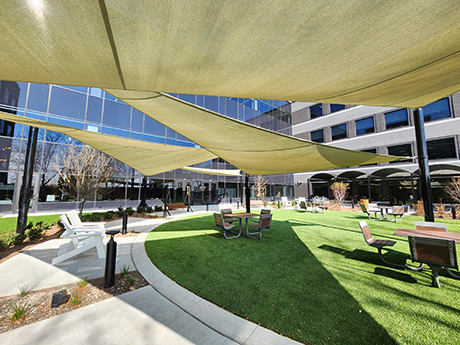By Maria Davis and Colton Rupprecht, R&R Real Estate Advisors
In the real estate industry, customer expectations around office space have undergone a significant shift — both in what they need and what they want. It’s not just about square footage anymore; it’s about how that space functions, feels and aligns with the values of the companies who occupy it.
This transformation is playing out in three critical areas: the rise of small, amenity-packed spaces; a surge in outdoor-focused design that brings the comforts of home into the workplace; and a more rooted and interactive approach to sustainability.

Smarter spaces
As more companies return to in-office work, many are rethinking how they use space — prioritizing flight to quality. Increasingly, customers are gravitating toward compact offices that offer high-impact amenities rather than expansive square footage. These smaller footprints are more efficient, but they also demand more thoughtful design and planning.
Technology is key in amenity designing, as efficient developers are integrating infrastructure that anticipates the needs of a tech-forward workforce. Whether it’s bracketing out spaces for high-speed fiber and built-in video conferencing hubs or artificial intelligence (AI)-powered building systems that manage lighting, the design is important in making a more amenity-maximizing space.

At the same time, brokers play a key role in helping customers bring their vision to life. Customers often have a clear sense of what they want: how the space should function, where it should be located and what it should feel like. The most effective brokers match customers with spaces that align with their goals, optimizing layout, amenities and capacity needs.
Bring the outdoors in
While smart interiors are one part of the story, what lies just beyond the threshold is just as vital. Increasingly, outdoor features have moved higher on the list of what people value in a space — not just as amenities, but as essential elements that make a place feel more like home.
At R&R Realty Group, the design and construction team has been leaning into this change, reimagining outdoor areas as a part of space customization rather than an afterthought. A recent renovation at Arcadia in West Des Moines, Iowa, illustrates this, incorporating pickleball courts, walking trails and an outdoor meeting area that redefines how outdoor spaces can support and elevate the workplace.
With spaces, versatility makes all the difference when it comes to merging a space between the inside and the outside. Landscaped rooftops can double as event venues, patios can become outdoor conference rooms and quiet gardens could be a place for employees to recharge. Choosing a space that is conscious of the outside world is continuously becoming relevant.
Sustainability is key
Perhaps the most meaningful shift, however, is how sustainability has become a constantly evolving conversation among developers, brokers and customers. From the earliest stages of property development, there’s a strong emphasis on thoughtful, sustainable design. R&R Realty Group’s development services subsidiary has a commitment to sourcing repurposed or reused environmentally responsible materials — an intentional effort that sets the tone for every project.
As new spaces take shape, sustainability remains a central theme, particularly as outdoor amenities become more in demand. The goal is not just to meet environmental standards, but to create spaces that are both functional and forward-thinking.
This mindset extends well beyond development. R&R Realty Group’s brokerage team stays closely attuned to customer feedback, ensuring that sustainability requests are heard. For instance, in response to growing interest in electric vehicle (EV) accessibility, the team has worked closely with property management to install EV charging stations, or to ensure infrastructure is in place for future installation.
Keeping open lines of communication with customers is key to this approach, ensuring their evolving sustainability needs are not only met but anticipated.
The future of office space
With these three shifts in mind, there’s been an increase in office spaces that are defined by their ability to be customized to the customers’ desires. Achieving a customer’s vision is only possible through ongoing collaboration among brokers, developers and the businesses they serve.
Maria Davis is a senior vice president and Colton Rupprecht is a commercial real estate representative with R&R Real Estate Advisors. This article originally appeared in the June 2025 issue of Heartland Real Estate Business magazine.


